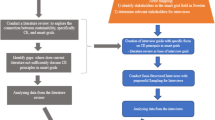Abstract
To deal with externalities associated with electricity generation, under the Polluter Pays Principles (PPP), companies can be made to pay the compliance costs and then pass these costs incurred on to the end-users by charging a higher price per kWh of electricity used. However, there is a need for an optimal liability scheme, in terms of economic efficiency, equity and ethics in a world of favor seeking politics. With implicit weighting of welfare gains and losses to society, we developed supply-demand models. By incorporating plausible parameter values into the models, the optimal liability shares fell to less 100 percent (full) liability. However, the model is very sensitive to changes in the parameter values.
Similar content being viewed by others
References
Andresen, S. et al. (2002). “The Feasibility of Ambitious Climate Agreements.” Working Paper 2002:3, CICERO, Norway.
American Electric Power (AEP). (1999). “Long Term Forecasting Report-1999.” AEP Report submitted to the Public Utilities Commission of Ohio.
American Electric Power (AEP). (2000). “Long Term Forecasting Report-2000.” AEP Report submitted to Public Utilities Commission of Ohio, OP Co.: Case No. 00-201-EL-FOR and CSP: Case No. 00-202-EL-FOR.
Coase, R. (1960). “The Problem of Social Cost.” Journal of Law and Economics. 3(1), 1–44.
Cole, D. & Grossman, P. (1999). “When is Command-and-control Efficient? Institutions, Technology, and the Comparative Efficiency of Alternative Regulatory Regimes for Environmental Protection.” Wisconsin Law Review. 1999(5), 887–938.
Energy Information Administration (EIA). (1998). “US Department of Energy Emission of Greenhouse Gases in the United States.” DOE/EIA-0573 (98). Office of Integrated Analysis and Forecasting, Washington, DC.
First Energy Company (FE). (1999). “Electric Long-Term Forecast Report-1999.” FE Report submitted to the Public Utilities Commission of Ohio, 2000.
Griffin, J. (1974). “The Effects of Higher Prices on Electricity Consumption.” The Bell Journal. 5(2), 514–538.
Intergovernmental Panel of Climate Change (IPCC). (2001). “Climate Change 2001-Impacts, adaptation, and Vulnerability.” Technical Summary of the Working Group II Report, UNEP.
International Institute for Sustainable Development (IISD). (2001). “Climate News-An Electronic Newsletter.” Dated, October 15, 2001.
Lee, B. (2000). “DJ US Senate Bill Provides Carbon Sequestration Tax Break.” Dow Jones Newswires, July 27, 2000.
McLoughlin, J. (1993). Environmental Pollution Control: An Introduction to Principles and Practice of Administration, London: Graham & Trotman.
Mishan, E. (1971). “Pangloss on Pollution.” Swedish Journal of Economics. 73(1), 127–136.
Morss, M. (1992). “Testimony Before the Public Utilities Commission of Ohio.” Case No. 92-790-EL-ECP.
Nordhaus, W. (1991). “The Cost of Solving Climate Change: A Survey.” The Energy Journal. 12(1), 37–65.
Plater, Z, et al. (1998). Environmental Law and Policy: Nature, Law, and Society, St. Paul, Minnesota, USA: West Group Publishing Co.
Pigou, A. (1932). The Economics of Welfare, London: Macmillan
Pimentel, D. & Pimentel, M. (1996). Food, Energy and Society, University Press of Colorado.
Public Utilities Commission of Ohio (PUCO). (2000). Ohio Utility Rate Survey'. PUCO, August 2, 2000.
Public Utilities Commission of Ohio (PUCO). (1992). “Acid Rain Compliance Report.” Case No. 92-790-EL-ECP.
Randall, A. (1972). “Market Solutions to Externality Problems: Theory and Practice.” American Journal of Agricultural Economics. 54, 175–183.
Rahman, A. (2000). “Greenhouse Gases Emission in the Midwest: System Approach to Policy and Planning under Liability Rules.” Ph.D. thesis, Environmental Science Graduate Program, Columbus, Ohio, The Ohio State University.
Rahman, A. (2002). “Market System to Curtail Emission Magnitudes Evolved from Electricity Generation, Environmentalists.” The International journal for all Professionals. 22(4), 387–392.
Sullivan, A. (1986). “Liability Rules for Toxic Clean-Up.” Journal of Urban Economics 20 (September), 191–204.
White, M. & Wittman, D. (1979). “Long-RunVersus Shor-Run Remedies for Spatial Externalities: Liability Rules, Pollution Taxes and Zoning.” In D. Rubinffed (ed.), Essays on the Law and Economics of Local Government. Urban, Institute: Washington, DC, Urban, pp. 1–33.
Author information
Authors and Affiliations
Rights and permissions
About this article
Cite this article
Rahman, A.M., Edwards, C.A. Economics of Polluter Pays Principles for Mitigating Social Costs of Electricity: A Search for an Optimal Liability Share. European Journal of Law and Economics 17, 73–95 (2004). https://doi.org/10.1023/A:1026337909871
Issue Date:
DOI: https://doi.org/10.1023/A:1026337909871




